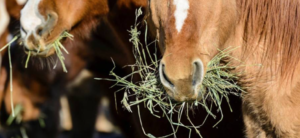 Steaming Hay One Component of Managing Equine Asthma: According to one recent study*, steaming hay, a common strategy for managing horses suffering severe equine asthma, may not help relieve the clinical signs of asthma in all horses.
Steaming Hay One Component of Managing Equine Asthma: According to one recent study*, steaming hay, a common strategy for managing horses suffering severe equine asthma, may not help relieve the clinical signs of asthma in all horses.
“Strategies such as soaking or steaming hay, housing asthmatic horses outdoors, and other allergen-avoidance techniques, in addition to medications recommended by veterinarians, are important means of managing this condition,” explained Kathleen Crandell, Ph.D., a Kentucky Equine Research nutritionist.
Management:
Crandell uses the term “management,” as there is no cure for this progressive and potentially debilitating condition. The underlying mechanics of equine asthma remain unclear, as researchers are still unsure which pro-inflammatory cytokines contribute to the condition. Is it interleukin 1β, a classic fall guy for most bodily inflammation, or interleukin 5, the inflammatory mediator currently being examined to create an “asthma vaccine”? Are other cells or mediators involved?
Past studies suggest that soaking hay lowers dust and molds. However, vitamin and mineral content might be negatively affected. Steaming hay, on the other hand, preserves the protein and mineral content of the hay with the effective reduction of respirable particles.
To determine the effectiveness of steaming hay, French veterinary researchers Orard and colleagues recruited horses with and without severe equine asthma. Both groups were offered steamed and dry hay for 5 days, with a 26-day washout period between the trials. All horses underwent assessment for their asthma clinical score, tracheal mucus accumulation, bronchoalveolar lavage fluid analysis (a “lung wash”), and mRNA expression of various inflammatory mediators.
Effectiveness of Steaming Hay:
Feeding steamed hay significantly decreased the mold content, as expected, and mucus score significantly increased when feeding dry hay. However, the clinical score of equine asthma found no significant influence.
“Above all, this goes to show that no single method will alleviate clinical signs in all horses,” Crandell said. “Managing a horse with equine asthma often requires multiple adjustments, which can include steaming hay. Not all horses in this study showed improvements. However, many horse owners have successfully used this tactic to help their horses breathe easier.”
As a result, the researchers concluded, “Steaming significantly decreased mold content but inconsistently influenced the respiratory response of sEA [severe equine asthma] affected horses when fed hay. Based on lavage fluid analysis cytology and cytokine profiles, its relevance might be controversial as a non-medicinal therapy for sEA-affected horses.”
The authors of the recently revised Consensus Statement on Equine Asthma** advise that any method of decreasing environmental exposure to known allergens like mold and dust from hay may help. In addition, they also recommend using omega-3 fatty acids to facilitate the management of equine asthma.
“Kentucky Equine Research offers EO-3, which contains 9,450 mg of marine-derived omega-3 fatty acids per serving, including DHA and EPA. This product is top-dressed onto the feed to support horses with equine asthma,” Crandell said.
In conclusion, do you have questions about Managing Equine Asthma? Contact us at J & J Hay Farms by clicking here!
Resources:
*Orard, M., E. Hue, A. Couroucé, et al. The influence of hay steaming on clinical signs and airway immune response in severe asthmatic horses. BMC Veterinary Research. In press.
**Couëtil, L.L., J.M. Cardwell, V. Gerber, et al. 2016. Inflammatory airway disease of horses—Revised consensus statement. Journal of Veterinary Internal Medicine. 30(2):503-515.
